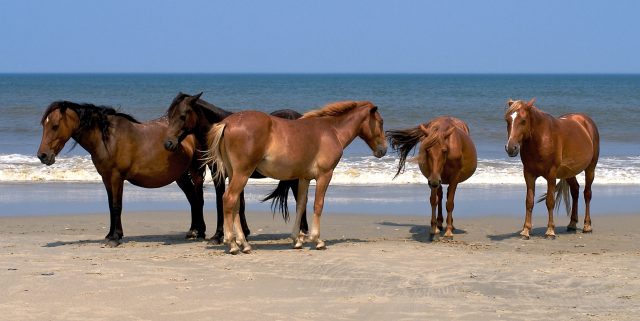Type the name of the breed you're looking for below
[wpdreams_ajaxsearchlite] Don't see the breed your're looking for? Click here and let us know!
Banker horse
| Country Of Origin | United States |
| History and Background | Since they are free-roaming, Bankers are often referred to as "wild" horses; however, because they descend from domesticated ancestors, they are feral horses. It is thought that the Bankers arrived on the barrier islands during the 16th century. Several hypotheses have been advanced to explain the horses' origins, but none have yet been fully verified. One theory is that ancestors of the Banker swam ashore from wrecked Spanish galleons. Ships returning to Spain from the Americas often took advantage of both the Gulf Stream and continental trade winds, on a route that brought them within 20 miles (32 km) of the Outer Banks. Hidden shoals claimed many victims, and earned this region the name of "Graveyard of the Atlantic". At least eight shipwrecks discovered in the area are of Spanish origin, dating between 1528 and 1564. These ships sank close enough to land for the horses to have made the shores. Alternatively, during hazardous weather, ships may have taken refuge close to shore, where the horses may have been turned loose. However, the presence of horses on Spanish treasure ships has not been confirmed—cargo space was primarily intended for transporting riches such as gold and silver. Another conjecture is that the breed is descended from the 89 horses brought to the islands in 1526 by Spanish explorer Lucas Vázquez de Ayllón. His attempted colonization of San Miguel de Gualdape (near the Santee River in South Carolina) failed, forcing the colonists to move, possibly to North Carolina. Vázquez de Ayllón and about 450 of the original 600 colonists subsequently died, as a result of desertion, disease, and an early frost. Lacking effective leadership, the new settlement lasted for only two months; the survivors abandoned the colony and fled to Hispaniola, leaving their horses behind. A similar theory is that Sir Richard Grenville brought horses to the islands in 1585, during an attempt to establish an English naval base. All five of the expedition's vessels ran aground at Wococon (present-day Ocracoke). Documents indicate that the ships carried various types of livestock obtained through trade in Hispaniola, including "mares, kyne [cattle], buls, goates, swine and sheep." While the smaller vessels were easily refloated, one of Grenville's larger ships, the Tiger, was nearly destroyed. Scholars believe that as the crew attempted to lighten the ship, they either unloaded the horses or forced them overboard, letting them swim to shore. In a letter to Sir Francis Walsingham that same year, Grenville suggested that livestock survived on the island after the grounding of his ships. |
| Use Today | Wild Animals, Pleasure mount, Riding horse |
| Height | 13 to 14.1 hands high (52-56 inches, 133-142 centimeters) |
| Colour | Any colour |
| Characteristics | The forehead is broad and the facial profile tends to be straight or slightly convex. The chest is deep and narrow and the back is short with a sloped croup and low-set tail. Legs have an oval-shaped cannon bone, a trait considered indicative of "strong bone" or soundness. The callousities known as chestnuts are small, on some so tiny that they are barely detectable. Most Bankers have no chestnuts on the hind legs. The coat can be any colour, but is most often brown, bay, dun, or chestnut. Bankers have long-strided gaits and many are able to pace and amble.Several of the Bankers' characteristics indicate that they share ancestry with other Colonial Spanish Horse breeds. The presence of the genetic marker "Q-ac" suggests that the horses share common ancestry with two other breeds of Spanish descent, the Pryor Mountain Mustang and Paso Fino. These breeds diverged from one another 400 years ago. The breed shares skeletal traits of other Colonial Spanish horses: the wings of the atlas are lobed, rather than semi-circular; and they are short-backed, with some individuals possessing five instead of six lumbar vertebrae. No changes in function result from these spinal differences. The convex facial profile common to the breed also indicates Spanish ancestry. |
| Personality and Temperament | They are easy keepers and are hardy, friendly, and docile. |



